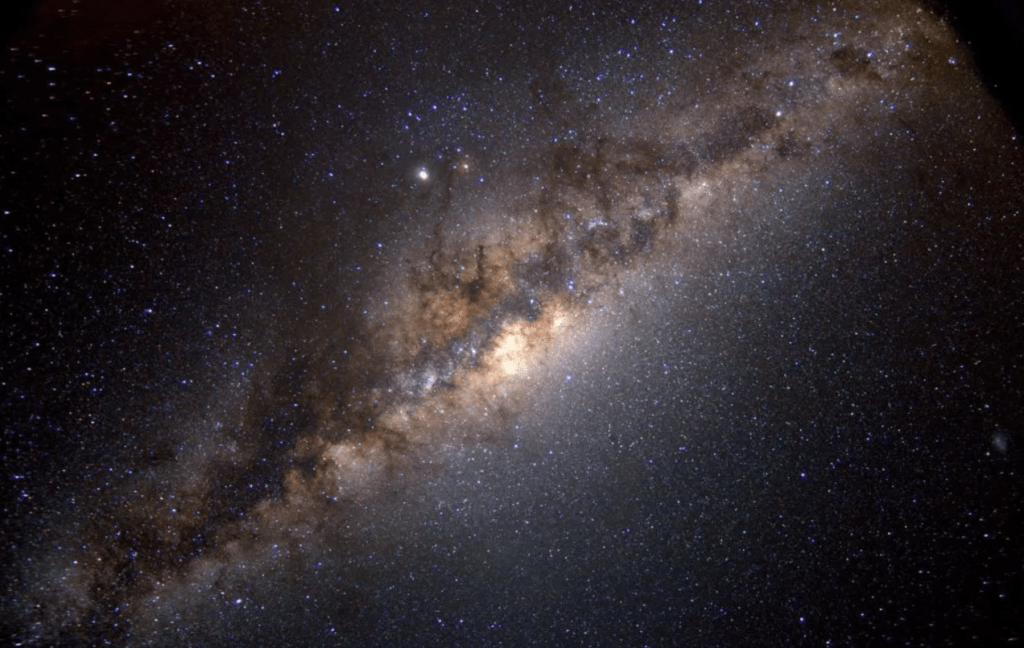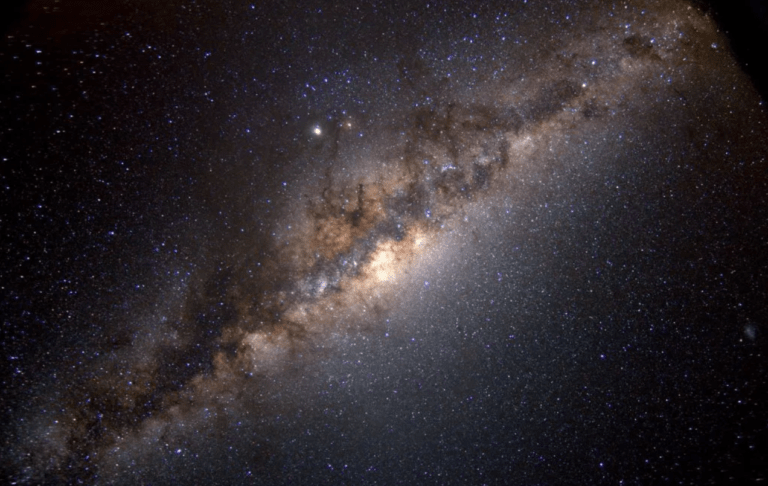The Curvature of the Milky Way: A Possible Influence of Dark Matter
The Peculiar ‘Wobbling Disk’ in Our Galaxy Could Stem from an Inclined Halo of the Universe’s Enigmatic Matter.
Astronomers may have finally found an explanation for the peculiar tilt and warped shape of our galaxy, the Milky Way. They attribute this phenomenon to a football-shaped, tilted halo of dark matter that surrounds our galaxy.

Our conventional perception of the Milky Way envisions it as a flat, disk-like structure, similar to a vinyl record. What may not be immediately apparent is the flared skirt at its edge, resembling the outer ring of a frisbee. Upon closer examination, scientists have discovered that the spiral galaxy’s disk has a warp, making it more akin to a frisbee that has been bent and twisted. These characteristics have intrigued researchers for some time.
Now, a team of astronomers from the Center for Astrophysics | Harvard and Smithsonian (CfA) has conducted calculations suggesting that the dark matter halo enveloping the Milky Way is not aligned as expected, which may be responsible for the flared edge and the warped shape of our galaxy. This revelation holds the potential to enhance our comprehension of the Milky Way’s evolution and offers insights into the enigmatic nature of dark matter and its impact on the development of galaxies.
Dark matter presents a challenge for scientists because it does not interact with light and is effectively invisible, composed of different particles than everyday matter. Nevertheless, it accounts for up to 85% of the universe’s matter content, while visible matter, the stuff making up stars, planets, and everything we encounter in daily life, constitutes only around 15% of the universe’s matter.
Scientists have inferred the presence of dark matter primarily through its gravitational effects on ordinary matter and light. This gravitational influence is critical because galaxies rotate at such high speeds that the gravitational pull of visible matter alone would not suffice to prevent them from disintegrating. Dark matter acts as the gravitational force that holds galaxies together.
As a result, it is believed that most, if not all, galaxies are surrounded by a halo of dark matter. In the case of the Milky Way, this dark matter halo extends beyond the region occupied by the stars encircling the galaxy’s central disk and nucleus.
Previously, the same Harvard team determined that the Milky Way’s stellar halo exhibited an elliptical or football-like shape with a noticeable tilt concerning the galaxy’s primary disk. They hypothesized that the shape of the dark matter halo would closely resemble the stellar halo, albeit more extensive.
Using computer models, the team has now refined this inference by demonstrating that the motion of stars aligns with a tilted, football-shaped dark matter halo. This alignment closely matches the Milky Way’s flared edge and warp.
Charlie Conroy, a member of the study team and a professor of astronomy at the CfA, remarked, “A tilted dark halo is actually fairly common in simulations, but no one had explored its effect on the Milky Way. It turns out that the tilt is an elegant way to explain both the magnitude and direction of our galaxy’s wobbly disk.”
Additionally, the team’s findings support the notion that the Milky Way has evolved through mergers with other galaxies. Jiwon Jesse Han, the study team leader and a scientist affiliated with the CfA, explained, “If the galaxy was just evolving on its own, it would have had this nice, spherical halo; this nice, flat disk. So the fact that the halo is tilted and has a football-like shape suggests that our galaxy experienced a merger event, where two galaxies collide.”
Calculating the shape of the dark matter disk surrounding the Milky Way could provide insights not only into the galaxy’s evolutionary history but also into the nature of dark matter. It may reveal properties of the particles comprising this mysterious substance that dominates our universe. Moreover, the findings could aid astronomers in studying free-floating “blobs” of dark matter that are believed to drift between galaxies.
Han concluded, “The fact that the galaxy is not spherical in our data implies that there is some limit to which dark matter can interact with itself.”
Source:SpaceCom
Do not forget to share your opinion with us to provide you with the best posts !




0 Comments